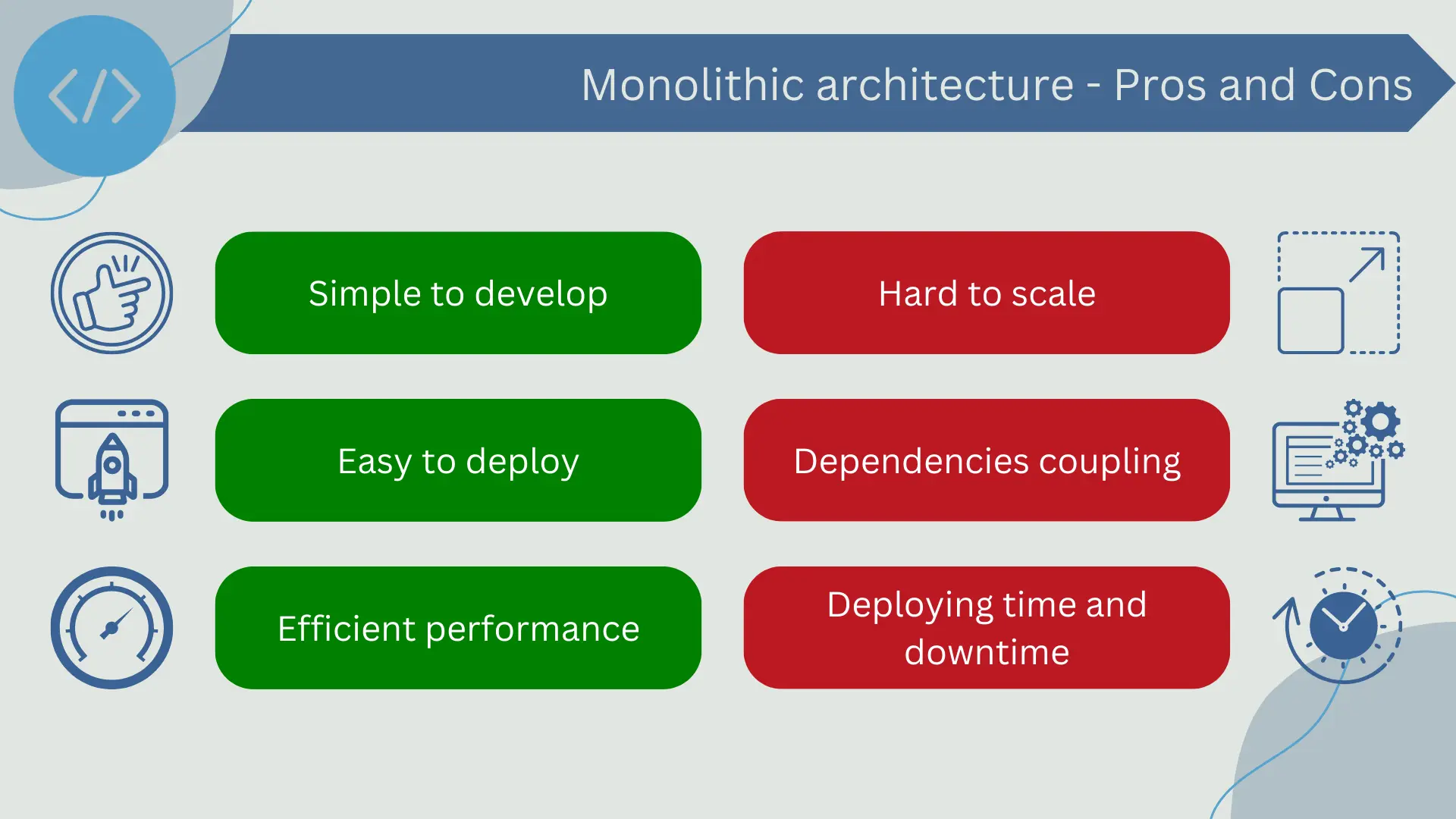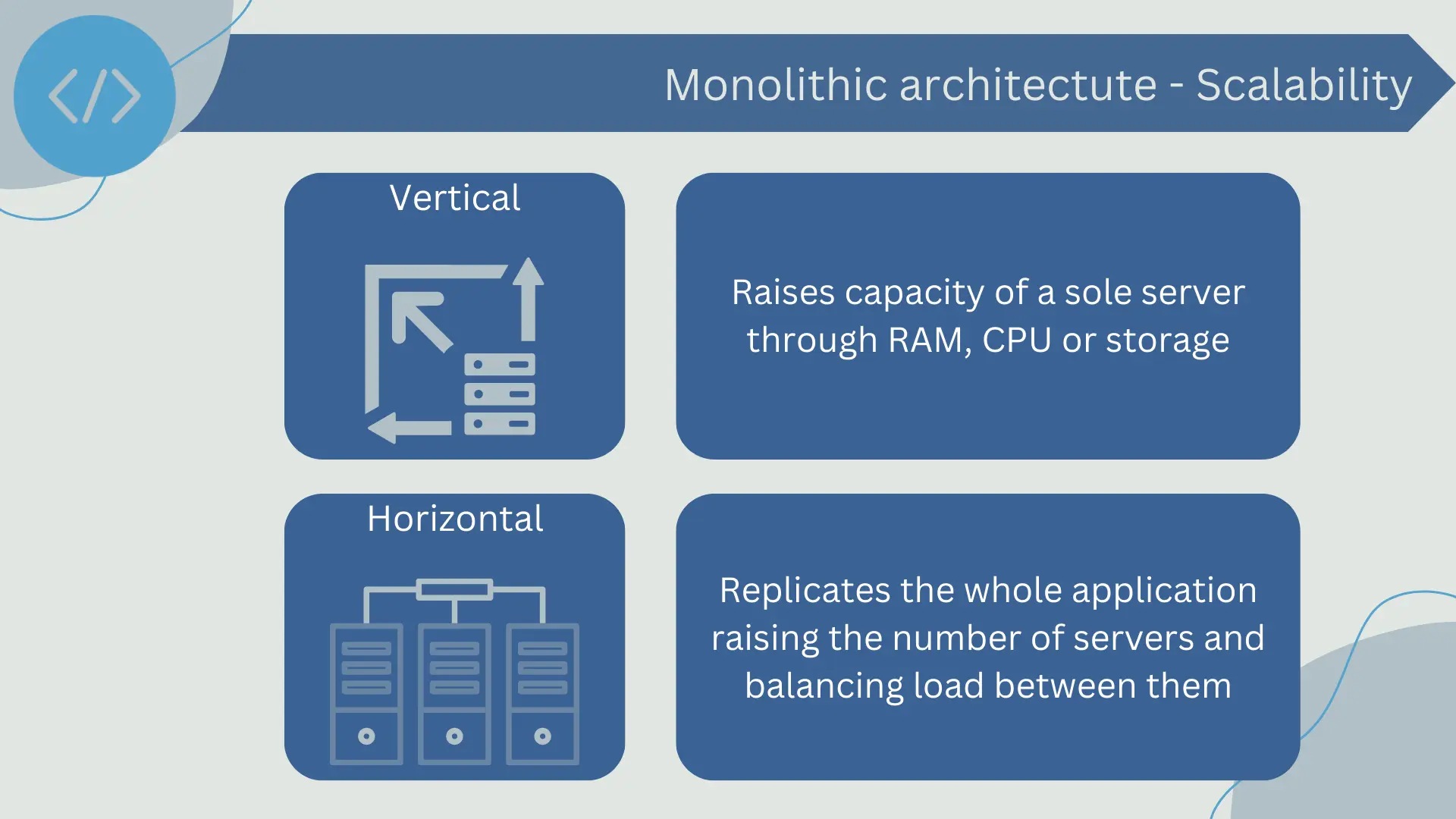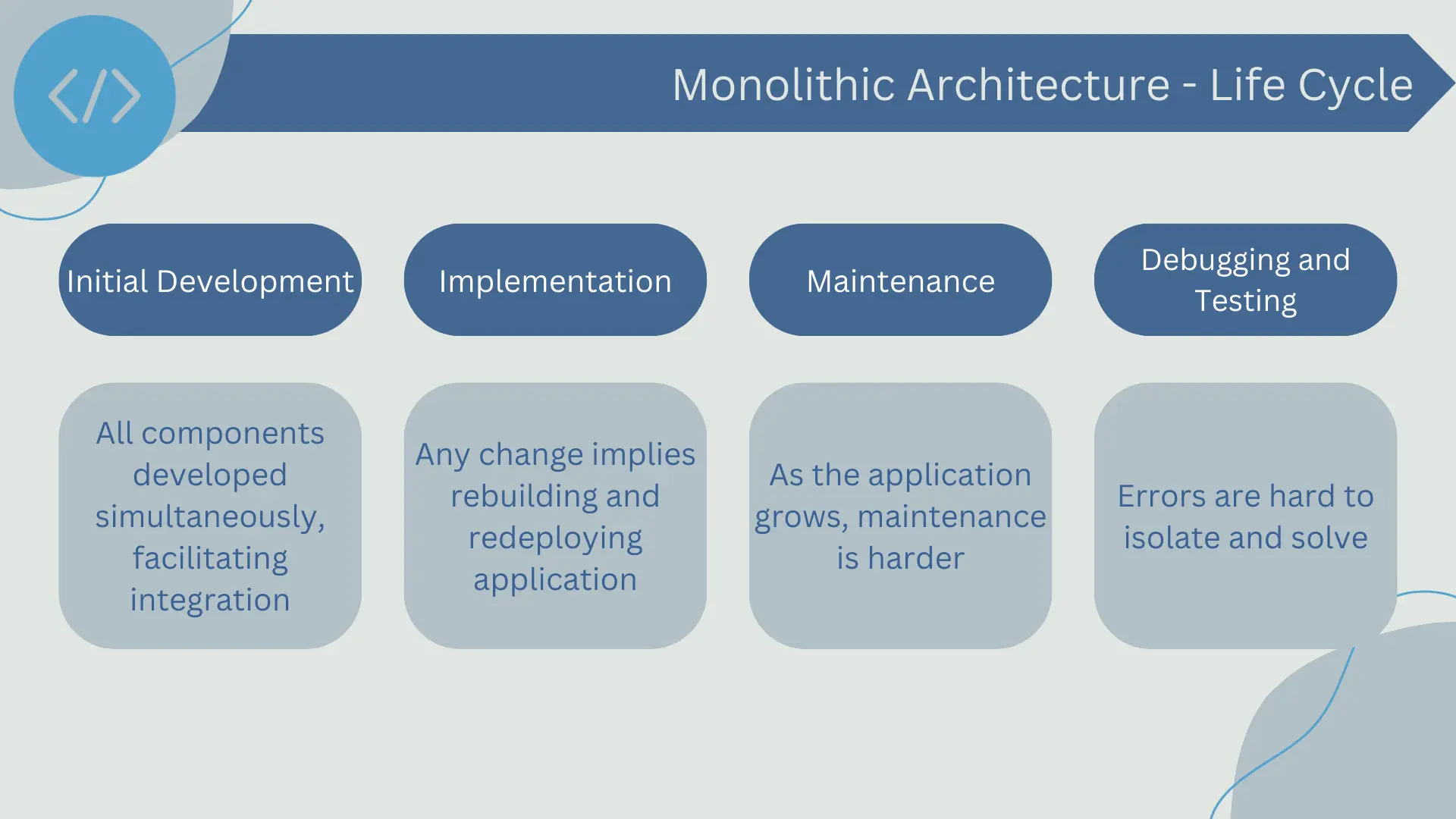Monolithic architecture is one of the oldest and traditional software architecture patterns. In this pattern, all the functionalities and components of an application are combined into a single unit or module. Generally, a monolithic application is internally divided into different functional components such as the user interface, business logic management, and data access layer, but these components are tightly interconnected and executed within a single process.
It is important to highlight some key characteristics of monolithic architecture:
- Simplified development: Monolithic applications are easy to develop due to the linear and predictable nature of development. There are no network dependencies, and development, testing, and debugging can be simpler compared to other architectural styles.
- Easy deployment: Monolithic applications are easy to deploy since you only need to copy the compiled executable to the desired server. There is no need for coordinating multiple services.
- Performance: Since all the components of the application run within the same process, monolithic applications can have efficient performance as they don't need to make costly network calls between services.
However, despite these benefits, monolithic architecture also has its challenges:
- Scalability: Scaling a monolithic application can be challenging as whenever more capacity is needed, the entire application needs to be scaled instead of just the component that requires more resources.
- Dependencies: In a monolithic application, all the components are tightly coupled and depend on each other. This means that a change in one area of the code can have unexpected side effects on other areas.
- Deployment time and downtime: Since everything is deployed as a single unit, a change in any part of the code requires a complete deployment. This can lead to longer deployment times and more downtime during updates.

Despite these challenges, monolithic architecture can still be a good choice for small and simple applications where the ease of development and deployment outweigh the scalability and dependency challenges. However, for larger and more complex applications, other architecture patterns like microservices or hexagonal architecture may be more suitable.
Internal Structure
Monolithic architecture is defined as an application that is built as a cohesive and unified unit. While it is referred to as a single unit, this application is internally composed of different interconnected components or modules that address specific functions within the system. These modules are not independent in terms of operation and execution but are part of a single process. Although the application is an indivisible whole from the perspective of its implementation and deployment, internally, the application can be well-structured and organized into different layers of responsibility.
The most common layers in a monolithic architecture are:
- Presentation layer: Also known as the user interface (UI) layer, this is the layer that directly interacts with the user. It can be composed of web pages, mobile application interfaces, command-line interfaces, among others. Its function is to collect user inputs and display data and results to the user.
- Business logic layer: This is the layer that handles the core logic of the application. This is where business rules are implemented and data is processed. This layer communicates with the presentation layer to receive user inputs and with the data layer to store or retrieve data.
- Data access layer: This layer interacts directly with databases or any other data source. Its purpose is to handle all operations related to data, such as CRUD (Create, Read, Update, Delete) operations and database queries.
These layers interact with each other to carry out the operations of the application. For example, when a user performs an action in the user interface, this action is transmitted to the business logic layer, which processes the action and may request or modify data in the data access layer.
Although these layers are logically separated, they are physically executed in the same process and tightly coupled. This means that a change in one layer can have impacts on the other layers. For example, a change in the data access layer may require corresponding changes in the business logic layer and possibly also in the presentation layer.
In a monolithic architecture, the code for each of these layers is combined into a single codebase, and the application is deployed as a single unit. While this can simplify development and deployment, it can also make the application more challenging to scale and maintain as it grows.
User request handling
In a monolithic architecture, handling user requests is done in a linear and predictable manner, typically through a single system. When a user makes a request, that request is processed within a single system and follows a predictable path through the different layers of the application.
Typically, the user request is processed as follows:
- Request reception: The user request, which can be an action performed in the user interface or an HTTP request, is initially received in the presentation layer. This layer is responsible for collecting user inputs and formatting them for further processing.
- Request processing: Once the presentation layer has received and formatted the request, it passes it to the business logic layer. This layer is where the request is processed. For example, if the request is to create a new record, the business logic layer will check business rules such as validation constraints and process the request accordingly.
- Data access: During the request processing, the business logic layer may need to access data stored in the database. To do this, it communicates with the data access layer, which handles all operations related to the database.
- Response: Once the request has been processed, and any necessary data access operations have been completed, the business logic layer generates a response. This response is passed back to the presentation layer, which formats the response in a suitable format for the user (such as a web page or an API response) and sends it back to the user.
Due to the monolithic nature of this architecture, all these operations are performed within a single system and process. This can simplify development and testing as there is no need to handle communication between different services or processes. However, it can also make the application more challenging to scale and can be a single point of failure. For example, if one component of the application fails, it can render the entire application inaccessible. Additionally, since all requests are processed within a single system, the performance of the application can be impacted if a large number of requests are received simultaneously.
Scalability
Scalability is a significant challenge in the context of monolithic architecture. Since the entire application runs as a single unit, scaling a part of the application often involves scaling the entire application.
Scalability refers to the ability of a system to handle an increase in workload. In the context of software applications, this can mean the ability to handle a higher number of users, more requests, or more data.
There are two main approaches to scaling a monolithic application:
- Vertical Scaling: Also known as "scaling up," it involves increasing the capacity of a single server by adding more resources such as memory, CPU, or storage. This approach can be effective to a certain extent but has its limitations. Physical servers have a limit to the amount of resources they can have, and upgrading a server can be costly and require downtime.
- Horizontal Scaling: Also known as "scaling out," it involves duplicating the entire application on multiple servers and load balancing the traffic between them. This approach can be more effective in handling significant increases in load but also has its challenges. Coordination between the different instances can be complex, especially if they need to share data.

An inherent problem with monolithic architecture is that individual parts of the application cannot be scaled independently. If one part of the application, such as the business logic, requires more resources, the entire system needs to be scaled. This can be inefficient and costly.
Furthermore, the scalability of monolithic applications can be limited by their tightly coupled nature. Since all components are interconnected, a bottleneck in one part of the application can affect the performance of the entire application.
Finally, scalability in monolithic applications can be more challenging in terms of development and maintenance. As the application grows, the codebase can become large and complex, making it difficult to introduce changes and new features. The need to coordinate and deploy changes across the entire application can slow down development and increase the risk of errors.
Development and lifecycle
The development lifecycle of a monolithic application has distinctive characteristics and presents specific challenges and benefits.
- Initial development: In the early stages of development, monolithic architecture can be simpler and straightforward to implement. All components of the application are developed and tested together, which can facilitate integration and coordination. Additionally, there is no need to build and maintain infrastructure and tools for communication and coordination between independent services, as may be required in other architectures like microservices.
- Deployment: In a monolithic architecture, the entire application is deployed as a single unit. This means that any changes in any part of the application require a complete recompilation and redeployment. This characteristic can make the deployment process slower and increase the risk of downtime and errors.
- Maintenance and updates: As the application grows and evolves, maintaining and updating a monolithic application can become more challenging. Due to the interconnection of components, changes in one part of the application can have unexpected side effects in other parts. Additionally, as the codebase grows, it can become harder to understand and manage, which can slow down development and increase the risk of errors.
- Scaling and evolution: As the application grows and needs change, scaling the application or introducing new technologies and practices may be necessary. With a monolithic architecture, these changes can be more difficult to implement. Scaling often requires scaling the entire application, which can be inefficient and costly. And due to the interconnection of components, introducing new technologies or practices may require significant changes throughout the application.
- Debugging and testing: Debugging and testing can be more challenging in a monolithic architecture. Due to the interconnection of components, errors can be harder to isolate and troubleshoot. And testing may require running and verifying the entire application, which can be slower and resource-intensive.

While monolithic architecture can be simpler and straightforward for initial development, it can present challenges as the application grows and evolves. Development teams may need to carefully consider these issues and plan ahead to handle challenges in scalability, maintenance, and evolution.
Use cases
While the challenges and limitations of monolithic architecture are evident, especially when compared to more modern and scalable architectures like microservices, there are still many use cases where a monolithic architecture is the most appropriate choice. Here are some scenarios where this approach might be preferable:
- Small to medium-scale applications: For applications that don't expect high traffic or don't have a large amount of functionality, a monolithic architecture can be the most practical and cost-effective option. The simplicity of development, testing, and deployment of these applications can outweigh the lack of scalability and flexibility of a monolithic architecture.
- Applications with a small development team: Smaller development teams may find a monolithic architecture easier to manage as it doesn't require coordination of multiple services or teams. This approach can also be easier to understand and maintain for less experienced developers.
- Applications with interdependent functionality: In some applications, different components may be tightly interrelated and need frequent communication with each other. In these cases, a monolithic architecture can be more efficient as the communication between components happens within the same process, which can be faster than inter-service communication in a microservices architecture.
- Prototypes and MVPs (Minimum Viable Products): When developing a prototype or MVP, speed and simplicity are often more important than long-term scalability and flexibility. In these cases, a monolithic architecture can allow development teams to get a functional application up and running more quickly.
- Internal and line-of-business applications: For applications used internally within an organization and that don't require the scalability and high availability of consumer-facing applications, a monolithic architecture may be sufficient and more cost-effective.
While monolithic architecture has its limitations, it remains a valid choice for many applications, especially those that are smaller, simpler, or don't require high scalability or availability. Development teams should carefully consider the needs and limitations of their specific application when choosing the most suitable architecture.
